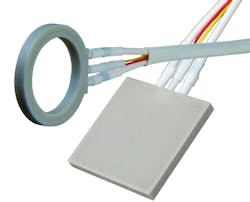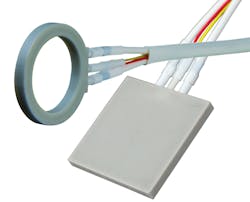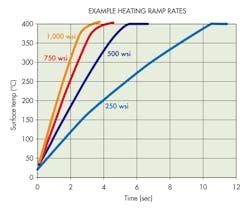This file type includes high resolution graphics and schematics.
The vast majority of traditional ceramic heaters use nichrome (NiCr) wire heating elements which are encapsulated in materials such as magnesium oxide (MgO), silicone rubber, or mica that are all electrically insulating but conduct heat poorly. The ΔT (difference in temperature) between the element wire and outer-heater surface limits the capabilities and performance of these types of heaters.
However, there are also advanced ceramic heaters that have a different kind of heating element. The heating element is often described as a “resistor trace” of deposited material. This material is typically planar rather than the coiled wire in traditional heaters. The trace can be deposited via different thick-film processes such as screen printing. The resulting circuits are just a few thousandths of an inch thick, and by matching their CTE (coefficient of thermal expansion) to that of the ceramic matrix material, they can be driven to much higher levels of thermal performance.
It is useful to review the properties of ceramic materials to better understand how the performance of advanced ceramic heaters arises. Ceramic materials are inorganic solids and may have a crystalline or partly crystalline structure, or can be amorphous (e.g., a glass). Pottery is one of the earliest examples of mankind’s use of ceramics. Pottery is made from naturally occurring clays which, when baked at a high temperature, become hard.
Over time, engineers developed new ceramics for specific applications. These materials are produced synthetically with exceptional purity so they can deliver specific mechanical, thermal, and electrical performance. Common manufacturing processes for these materials involve pressing powdered raw material at extremely high pressures, followed by sintering at high temperatures. The controlled purity and chemistry of the resulting material produces monolithic, geometrically stable structures that are of interest for use as heater material. The materials that can be used in advanced ceramic heaters include alumina (Al2O3), silicon nitride (Si3N4), beryllium oxide (BeO), and aluminum nitride (AlN).
Each of the advanced ceramic materials has its own mechanical, thermal, and electrical properties. Designers use these properties to match a particular ceramic with a particular heating application.
Aluminum nitride is especially interesting because it is highly thermally conductive as well as a good electrical insulator. AlN, cubic-BN, and BeO are the only ceramic materials that possess high thermal conductivity. Both BeO and c-BN conduct better than AlN, but the toxicity of BeO restricts its use and c-BN is difficult to produce. High thermal conductivity allows for the quick dissipation of heat and also facilitates construction of heaters with a high watt density, giving the ability to thermally “ramp” at a rate of up to 150°C (270°F)/sec. High ramp rates of this nature can save time in applications such as clinical diagnostic equipment and semiconductor chip testing where cycle time is important.
AlN is also a clean, noncontaminating material. It goes through high-temperature sintering that produces a heater that is hard (1,100-kg/mm2) and dense (3.2 gm/cc) with virtually no porosity. This makes AlN a good candidate for applications that need a “clean” heater.
AlN is impervious to moisture. (Many other dielectric materials used in conventional heaters — such as MgO — are hydroscopic.) That property, combined with its superhigh dielectric strength, make it attractive for applications that demand low leakage current. Low leakage current can be critical for medical applications that are in close proximity to patients. Equipment that incorporates traditional heating technologies may have to resort to step-down isolation transformers and low-voltage power supplies to meet agency safety regulations. In many cases, AlN-based ceramic heaters can eliminate the need for these transformers by providing the necessary electrical performance, even at standard line voltages.
AlN can be readily adapted to small and midsize heaters. Ceramic heaters of this sort can have dimensions as small as about 0.4 in. (10.16 mm) on a side, up to a maximum dimension of a little less than 4 in. (about 10 cm). They are typically a few tenths of an inch (a few millimeters) thick. They can also incorporate mechanical features such as holes and vacuum grooves and can be configured to operate from input voltages of 12 to 480 V.
These qualities let ceramic heaters produce up to 1,000 W/in.2 and operate at up to 600°C (1,112°F) depending on the heater design and process parameters. (Maximum and minimum power densities can vary with voltage, surface area, and application parameters.)
Edited by Leland Teschler, [email protected]
Resources: Watlow Electric Manufacturing Co.
This file type includes high resolution graphics and schematics.



